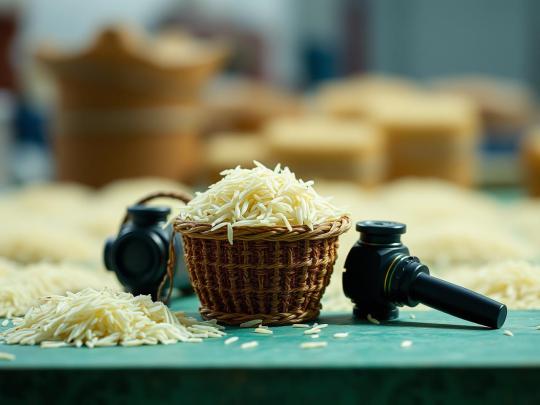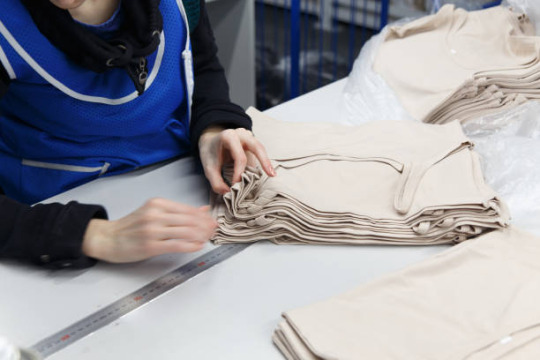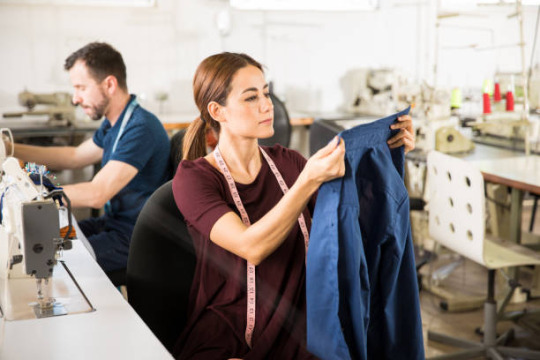#Moisture Analyzers Market
Explore tagged Tumblr posts
Text
According to a new report by Precedence Research, the global moisture analyzer market size was valued at USD 1.91 billion in 2023 and is projected to reach USD 3.42 billion by 2033, growing at a CAGR of 6% from 2024 to 2033
0 notes
Text
What Makes a Reliable Non-Basmati Rice Manufacturer?

Non-basmati rice is a staple food in many countries due to its affordable price, versatility, and varying grain sizes. From long-grain to short-grain varieties, it serves as the backbone of countless meals. But what’s the difference between an ordinary supplier and a reliable manufacturer when it comes to non-basmati rice? For wholesalers, retailers, and even consumers, choosing the right rice manufacturer can make a huge difference in quality, consistency, and long-term relationships. This blog will explore the key factors that ensure you’re sourcing from a trustworthy non-basmati rice manufacturer.
Quality Control Practices and Certifications
The foundation of any reliable rice manufacturer is its commitment to quality. Manufacturers with strict quality control processes ensure that each batch of rice meets specific standards for purity, grain length, moisture content, and taste. Look for manufacturers that adhere to international certifications such as ISO 9001 for quality management and HACCP (Hazard Analysis and Critical Control Points) for food safety. These certifications ensure that the rice is produced under clean conditions and undergoes rigorous testing to remove impurities.
Additionally, quality manufacturers often employ state-of-the-art testing laboratories that analyze rice for contaminants such as pesticides, aflatoxins, and heavy metals. This commitment to food safety ensures that you are getting a premium product that meets global standards.
Consistent Supply and Scalability
A reliable non-basmati rice manufacturer must be able to meet consistent demand, whether you are a small retailer or a large-scale distributor. This means maintaining adequate stock, having capacity for large orders, and increasing production as needed. Manufacturers with extensive farming networks or partnerships with multiple farmers can better guarantee stable supply throughout the year, regardless of seasonal fluctuations.
Scalability is especially important for businesses looking to expand into new markets. A trustworthy manufacturer will have the flexibility to adjust production volumes to align with your growth, ensuring a smooth supply chain even during peak seasons.
Technological advancements in milling and packaging
Modern rice milling and packaging technology plays a key role in maintaining the quality and shelf life of non-basmati rice. Reliable manufacturers invest in advanced milling machinery that reduces broken grains and preserves the natural texture and flavor of rice. Look for manufacturers that use automated sorting technologies to remove discolored or damaged grains, ensuring a more consistent product.
Packaging also matters. Vacuum-sealed or air-tight packaging helps preserve freshness and prevent moisture ingress, which can lead to spoilage or insect infestation. Manufacturers that adopt innovative packaging solutions help ensure that their rice reaches consumers in optimal condition.
Sustainable and ethical sourcing
As consumers and businesses are becoming more aware of sustainability, it is important to work with a manufacturer that values ethical sourcing. Reliable manufacturers prioritize environmentally friendly farming practices, such as minimizing the use of chemical pesticides and adopting water conservation methods. Some manufacturers also support small-scale farmers by offering fair trade agreements, ensuring that local communities benefit from their involvement.
Sustainably sourced rice also tends to be higher in quality, as the plants are grown in healthy soil, without an excessive reliance on synthetic chemicals. Look for manufacturers that openly share their sustainability initiatives or hold certifications such as Fairtrade or Organic to further validate their commitment to ethical practices.
Customer Support and Global Reach
Strong customer support is the hallmark of any reliable non-basmati rice manufacturer. A good manufacturer should provide clear communication channels, timely responses to inquiries, and efficient problem-solving when issues arise. This level of support fosters trust and ensures a seamless business relationship over time.
Additionally, manufacturers with a global reach and experience exporting rice to multiple countries are better equipped to handle the complexities of international shipping, customs regulations, and regional preferences. A manufacturer with a proven export track record can provide invaluable guidance, especially for businesses looking to expand internationally.
Choosing the right non-basmati rice manufacturer isn’t just about considering price. Quality control, supply continuity, technological advancements, consistency and customer support all play a vital role in ensuring you get a great product. By partnering with a reliable manufacturer, you can guarantee that your business will thrive and your customers will be happy.
2 notes
·
View notes
Text
Kickstart Your Fitness On How To Start a fitness Apparel Line: A Comprehensive Guide to Success

Launching a start-up fashion apparel business in the female fitness apparel niche is indeed a very engaging experience as it combines love for fitness clothing, fashion trends and, sports and business. The ultimate checklist to follow will help you to start the process of creating a profitable line of fitness wear.
Understanding of fitness clothing line

There are three main areas: choosing the best fabric for high performance, fabric weight, focusing on the stability, and adding in such things as the presence of moisture and breathing capability. Similarly everyday the athletic clothing line, the fitness clothing industry also top priority in terms of brand creation, market analysis, and marketing approach focused to the right demographic with keen interest in fitness and having a healthy lifestyle.
1. RESEARCH PLANNING

Understand the Market: Other recommendations include the following: Analyzing trends, target demographic, and players within the industry.
Choose Your Niche: To succeed in this competitive market, it is advisable to choose a niche, whether it is athleisure, performance wear, or sustainable materials.
Business Plan: Complete and submit the following plan as part of your proposal: plan: vision, goals, cost, and promotional plan.
2. PRODUCT DEVELOPMENT

Design Your Apparel: Other aspects of designs that needs to be taken into considerations include The purpose of the designs is to be unique that will appeal to the target audience.
Material Selection: Select materials of the highest quality that can resist wear and tear that often comes with many forms of physical training.
Prototype and Testing: Prototyping is the next step where one has to design and develop the prototypes of the concept and it is crucial to ensure that the gadgets created are functional, comfortable to wear and fashionable.
3. BRANDING AND IDENTITY

Brand Name and Logo: Namely, create a strong brand name and easily recognizable logo that would comply with the overall image of your brand.
Brand Story: Although a brand story does not necessarily identify neatly and distinctly with the audience, it is a building block by which you can create an emotional appeal as a way of communicating with the audience.
Brand Guidelines: It is imperative that what your brand represents on the Internet should resemble your offline brand image.
4. MANUFACTURING

Find a Manufacturer: Still using the example, try to research on the best manufacturer of the product that you would like to order within your set standard and financial capacity.
Sourcing Materials: Make sure that supplies of the chosen type of materials are constant.
Production Process: Supervise the manufacturing, or other processes, in order to ensure quality is not compromised.
5. LEGALITIES AND LICENSING

Business Structure: Decide on the right form of business to take (for example, LLC, sole proprietorship and others).
Licenses and Permits: The other important requirement includes; Securing the necessary business licenses and permits.
Trademark and Copyrights: Remember to safeguard your brand legally through the trademarks for the name, logo or any designs.
6. SETTING UP AN ONLINE PRESENCE

E-commerce Platform: Employ a friendly and easy to use e-business software to conduct your business with your customers.
Website Design: The need to create a website that is both attractive and easy to use cannot be overemphasized.
SEO and Content Marketing: Featured snippets must be implemented, and consistent development of content laced with SEO practices to accrue and maintain a loyal customer base should be the major goals.
7. MARKETING STRATEGY AND PROMOTION

Social Media Marketing: In this case, it is crucial to utilize social media platforms as a way of putting your brand out for people to see.
Influencer Collaborations: People follow the recommendations of their favorite personalities, especially in the online space, so use fitness influencers to advertise a new meal plan.
Email Marketing: In reference to the goal of increasing consumers’ purchases and maintaining their loyalty, it is vital to actively use e-mail campaigns to keep the target audience informed and involved.
8. LAUNCH AND GROWTH

Soft Launch: First, launch the product, specifically in a geographical location that will allow the research team to receive feedback before rebranding.
Official Launch: When your product is ready, ensure that it has a glamorous unveiling coupled with the promotions and campaigns.
Customer Feedback: Customers’ opinions can be heard through surveys, interviews or simply having them fill out a short questionnaire.
How Can You Choose the Suitable Fitness Clothing Manufacturer?
Choosing the right for fitness apparel brands and sports and fitness clothing brand by manufacturer involves several critical steps:
Research and Referrals

Always start your search online, and if you’re already connected to people in the fashion industry, ask for recommendations.
Evaluate Experience

In the case of sweaty gym and workout clothes made, the best manufacturers are those with specialization in manufacturing fitness apparel business apparels.
Check Quality Standards

Provide feedback on the quality control mechanisms used by the prospective suppliers and make sample demands.
Communication and Responsiveness

Guarantee that they are articulate and on the same page in terms of time.
Production Capacity and Flexibility

Check if they can fulfil your orders now and their ability to scale up for the future.
Cost and MOQs

You ought to compare costs and minimum order quantities (MOQs) that you will be willing to pay.
Ethical Practices

This means clothing manufacturers ensure that they adhere to the universally accepted ethical manufacturing standards.
FAQs

What is the first step in starting a fitness apparel line?
Ever before buying a product or designing one, a marketer needs to acquire some information in the niche market he intends to operate in.
How do I choose a niche for my fitness apparel line?
Keep it niche such as a sector, a category fitness clothing, or a material such casual clothing such as leisure-wear, sportswear, gym wear or eco-friendly material respectively.
What should be included in a business plan?
Describe your dream from day one, what you want to accomplish, how much money you will spend, solid business plan, how you will sell your product, and your business strategy and plan ROI.
How do I find a reliable manufacturer?
Research manufacturers, request samples, and assess their quality control, capacity, and ethical practices.
What legal requirements should I consider?
Choose a business model or structure to operate legally, Most legal business loans and structures require licenses and permits, and register a business name to safeguard your own business license and brand legally.
How can I build my brand identity?
It is also essential gym clothing brand to have a catchy brand name and logo that is geared towards attracting the intended audience to workout a fitness clothing line, as well as supporting them through a narrative.
What are the key elements of an online presence?
Establish an e-commerce site, create the storefront that consumers will want to frequent, and optimize the corporate website for search engine rankings.
How do I effectively market my fitness apparel line?
Get to market your own your own fitness clothing line, brand and products using social media marketing, brand association with influencers, e-mail marketing, and content quality.
Best advice to start a fitness clothing business
Allocation and the execution of goals and objectives, budget, sales and marketing strategies or the overall business plan is crucial. Brand your campaigns and target your audience through the proper use of social media, well-chosen influencers and online marketing. Marketing has to be properly developed, the web site has to be built in a way that it is easy to navigate, and contain optimized links that will bring buyers to the site. Remain open to change to stay in tune with emerging trends in the industry and target market, and with the opinion of the target customer to design better products and perform better business functions. Some of the tips involve; networking with professional industry players and looking for a mentor in the matter.
Conclusion
To sum up, it is crucial to outline the precise step-by-step plan when launching a fitness apparel line, from the accounting of the saturation in market and choice of the niche to creating the recognizable brand image. Hence, to create a niche fitness brand identity and carve out a space for itself within the cut-throat competition for quality fitness apparel and apparels, one must focus on quality fabrics, unique designs, and targeting the right consumer. And do not forget about using digital tools, addressing the audience through social networks, and being ready to adjust tactics according to tendencies and consumers’ responses. Fitness business or a new fitness clothing line or brand may sound a little blur, but if you are fully committed and employ adequate strategies, you can make a lot of money out of it such as workout clothes, gym apparel line and other new fitness clothing line and activewear manufacturers.
This would mean that undertaking this journey is more of a learning process and an experimentation process. It is crucial to remain connected with other professionals in the industry to be able to find support in the shape of a mentor, as well as always monitor the market situation to be able to manage on threats or even turn them into opportunities to sell workout clothes. To sustain the appreciation of the value these apparels have in the fitness industry or your own fitness clothing line or business and ensuring customer loyalty, one must strive to embrace a winning strategy that complies with the customer-oriented approach into your own fitness brand or fitness clothing line business.
#blog#clothing#fitnessapparel#business#fashion#clothing business idea#how to start a fitness apparel line
2 notes
·
View notes
Text
Unlocking Sales:Creative E-Commerce offer Ideas beyond discounts
Hey there, savvy ecommerce marketers! ��� Are you tired of relying solely on discounts to drive sales? It’s time to think outside the box and explore creative offer ideas that can skyrocket your revenue while delighting your customers. In this article, we’ll dive deep into innovative ecommerce offers that go beyond traditional discounts, helping you stand out in a crowded digital marketplace and achieve sustainable growth.

1. Bundle Deals that Wow
One way to entice customers is by offering bundle deals that combine complementary products at a discounted price. For example, a skincare brand could bundle a moisturizer, cleanser, and serum together, offering a complete skincare routine package at a compelling price point.
2. Tiered Rewards Programs
Implement a tiered rewards program where customers earn points or perks based on their purchase history or loyalty. As customers reach higher tiers, unlock exclusive benefits such as early access to sales, VIP customer support, or members-only discounts.
3. Surprise & Delight Gifts
Add a personal touch to your customer experience by surprising shoppers with unexpected gifts or samples with their purchases. This not only creates a positive brand impression but also encourages repeat purchases and word-of-mouth referrals.
4. Interactive Contests and Challenges
Engage your audience through interactive contests or challenges on social media platforms. Encourage user-generated content such as creative photos or videos featuring your products, and reward participants with prizes or discounts.
5. Charitable Initiatives
Showcase your brand’s commitment to social responsibility by partnering with charitable organizations or causes. Offer to donate a percentage of sales to a worthy cause, or launch special fundraising campaigns tied to specific products.
6. Subscription Benefits
Encourage customers to subscribe to your products or services by highlighting exclusive subscription benefits such as discounted pricing, automatic deliveries, or members-only perks.
By incorporating these innovative ecommerce offer ideas into your marketing strategy, you can capture the attention of potential customers, foster loyalty among existing ones, and ultimately drive sustainable sales growth. Remember to track and analyze the performance of each offer to optimize your strategy over time. Ready to take your ecommerce game to the next level? Let’s dive into the world of creative offers and unlock new opportunities for success! Free Consultation Reach Us Today!!!
#seo services#branding#social media metrics#facebook ads#marketing metrics#search engine marketing#facebook advertising#social media#digitalmarketing#best digital marketing company#search engine optimization#marketing#advertising
2 notes
·
View notes
Text
Tunable Diode Laser Analyzer (TDLA) Market Size, Share, Trends & Industry Growth Analysis Report 2031
Tunable Diode Laser Analyzer (TDLA) Market by Gas Analyzer (Oxygen, Ammonia, COx, Hx, Moisture, CxHx, NxOx), Device (Portable, Fixed), Methodology (In Situ, Extractive), Technology (Absorption, Emission), Operation, Component - Global Forecast to 2031
The tunable diode laser analyzer (TDLA) market size is projected to grow from USD 546.2 million in 2024 and is projected to reach USD 884.4 million by 2031; it is expected to grow at a CAGR of 7.1% from 2024 to 2031. The driving factors for the tunable diode laser analyzer (TDLA) market include rising industrialization and development of new power plants; advanced features of TDLAs and ROIs on installations; increased process automation in various end-use industries; growing applications in the pharmaceutical and healthcare sectors for enhanced process optimization and quality control and Increasing focus on environmental monitoring and adherence to regulatory standards will propel the TDLA market in the coming years.
0 notes
Text
Cottonseed Oil: Analyzing the Current Market Landscape
The global cottonseed oil market has witnessed steady growth due to its diverse applications in food processing, cosmetics, and industrial sectors. As one of the major vegetable oils derived from the seeds of cotton plants, cottonseed oil is known for its mild flavor, high smoke point, and nutritional benefits. It is commonly used for frying, salad dressings, margarine, and in the production of various packaged foods. In this article, we will examine the factors influencing the cottonseed oil market, current trends, and future prospects.
1. Market Drivers
One of the primary drivers of the cottonseed oil market is the increasing demand for edible oils, particularly in developing countries. As disposable incomes rise and consumer preferences shift toward processed and convenience foods, the demand for cooking oils like cottonseed oil continues to grow. The rising population, especially in regions such as Asia-Pacific, is contributing to the growth in demand for edible oils, including cottonseed oil, for domestic consumption.
Another key factor driving the cottonseed oil market is the growing awareness about the nutritional benefits of cottonseed oil. It contains a relatively higher amount of polyunsaturated fats, which are considered heart-healthy, making it a preferred option for consumers looking for healthier cooking alternatives. Additionally, the oil is a good source of essential fatty acids, which are beneficial for overall well-being.
2. Applications Across Industries
Cottonseed oil is highly versatile and finds application in a wide range of industries. The food industry remains the largest consumer of cottonseed oil, particularly in the production of cooking oils, margarine, salad dressings, and snack foods. Its stability at high temperatures and neutral taste make it an ideal ingredient for frying and deep-frying in fast food chains and commercial kitchens.
In the cosmetic industry, cottonseed oil is used in skin care products, soaps, and lotions due to its emollient properties, which help retain moisture and improve skin texture. The oil's mildness and rich fatty acid content also make it an effective ingredient in hair care products, such as shampoos and conditioners.
In addition, cottonseed oil is used in industrial applications, including the manufacturing of lubricants, soaps, and paints. The oil is an important raw material for biodiesel production as well, which is increasingly gaining attention as a sustainable and eco-friendly energy source.
3. Market Challenges
Despite the positive growth trends, the cottonseed oil market faces several challenges that could impede its expansion. One of the primary challenges is the competition from other vegetable oils such as soybean oil, palm oil, and sunflower oil, which are more widely produced and have lower prices. These alternative oils are often more readily available and may be perceived as more versatile, limiting the market share of cottonseed oil.
Another challenge is the fluctuations in cottonseed production due to weather conditions. Cotton is a crop that is heavily dependent on favorable weather conditions, and any adverse changes in climate or crop diseases can lead to reduced yields, which may, in turn, drive up the price of cottonseed oil. This makes the market vulnerable to price volatility, impacting both producers and consumers.
Additionally, concerns over the use of genetically modified (GM) cotton and the presence of pesticide residues in cottonseed oil have raised consumer concerns. The growing preference for non-GMO products in the market may lead to a decline in the demand for conventionally produced cottonseed oil. Producers will need to adapt by offering organic and non-GMO cottonseed oil options to meet consumer preferences.
4. Regional Insights
The demand for cottonseed oil varies by region, with Asia-Pacific, North America, and Europe being the largest markets. The Asia-Pacific region, particularly countries like India and China, represents a significant portion of the global demand for cottonseed oil. The increasing population and the growing trend of urbanization in these regions have led to a surge in demand for edible oils, including cottonseed oil. As consumer lifestyles become more fast-paced, the need for convenient and cost-effective cooking oils like cottonseed oil continues to rise.
In North America, the cottonseed oil market is driven by the high consumption of processed foods, snacks, and fast food. The United States is one of the largest producers of cotton in the world, making cottonseed oil production a significant part of the agricultural sector. However, competition from other vegetable oils, such as soybean oil, poses a challenge to the growth of cottonseed oil in the region.
Europe, known for its high demand for high-quality edible oils, is also a key market for cottonseed oil. However, as in other regions, the market faces competition from alternative oils, which could limit growth potential in this region.
5. Future Outlook
The cottonseed oil market is expected to continue its growth trajectory, driven by rising demand in developing regions, increasing awareness of health benefits, and the expansion of industrial and biodiesel applications. As the demand for healthier cooking oils increases, cottonseed oil's heart-healthy attributes may help boost its appeal among consumers seeking nutritious alternatives.
To capitalize on the growing market, producers will need to address challenges related to supply chain volatility, climate-related risks, and consumer preferences for non-GMO and organic products. Investing in sustainable and innovative production methods will be crucial for maintaining a competitive edge in the market.
The cottonseed oil market is also likely to benefit from increasing demand for sustainable energy sources, as biodiesel production continues to gain momentum globally. As more countries adopt renewable energy targets, cottonseed oil's role in biodiesel production could present new growth opportunities for the market.

Conclusion
In conclusion, the cottonseed oil market is poised for steady growth, fueled by increasing demand from the food, cosmetic, and industrial sectors. However, challenges related to competition, price volatility, and consumer concerns over GMO and pesticide residues must be addressed to ensure long-term market stability. By capitalizing on emerging trends, including sustainable production methods and biodiesel applications, the cottonseed oil market can unlock new opportunities and continue to thrive in the coming years.
Get Free Sample and ToC : https://www.pristinemarketinsights.com/get-free-sample-and-toc?rprtdtid=NDc1&RD=Cottonseed-Oil-Market-Report
0 notes
Text
Key Drivers Influencing the Tunable Diode Laser Analyzer Market
Key Drivers Influencing the Tunable Diode Laser Analyzer Market
Straits Research is pleased to announce the release of its comprehensive report on the Tunable Diode Laser Analyzer Market, which provides an in-depth analysis of market dynamics, trends, and projections for the coming years. This report is essential for stakeholders looking to navigate the evolving landscape of this critical technology.

Tunable Diode Laser Analyzers utilize advanced laser absorption spectroscopy techniques to measure the concentration of specific gases in a mixture. This non-contact method allows for rapid and accurate measurements, making TDLA an essential tool in applications ranging from ambient air quality monitoring to stack emissions testing. The technology’s capability to provide continuous measurements with minimal interference from other gases enhances its appeal in industries that require high precision and reliability.
Market Overview
The global tunable diode laser analyzer market was valued at USD 605.48 million in 2023. It is estimated to reach USD 1,089.96 million by 2032, growing at a CAGR of 6.75% during the forecast period (2024–2032). The increasing demand for accurate gas analysis in various industries, particularly in the chemical and pharmaceutical sectors, is a key driver of this growth. TDLA technology is crucial for ensuring safety and compliance with environmental regulations by monitoring hazardous gases and emissions effectively.
Request sample linK:https://straitsresearch.com/report/tunable-diode-laser-analyzer-market/request-sample
Definition and Latest Trends
Tunable Diode Laser Analyzers are advanced instruments used for precise measurement of gas concentrations in various applications, including environmental monitoring, process control, and emissions testing. These analyzers utilize tunable diode laser technology to provide real-time data with high sensitivity and specificity, making them indispensable in industries where gas composition is critical.Recent trends indicate a rising focus on environmental monitoring due to stringent regulatory standards aimed at reducing emissions. Additionally, advancements in automation technologies are leading to increased adoption of TDLA systems across various sectors. The integration of these analyzers into process control systems enhances operational efficiency and safety, further driving market growth.
Market Segmentation
The report segments the Tunable Diode Laser Analyzer market into several categories:
By Type
In-Situ
Extractive
By Gas Analyzer Type
Oxygen Analyzers
Ammonia Analyzers
COx Analyzers
Moisture Analyzers
Hx Analyzers
CxHx Analyzers
Others
By Device Type
Fixed
Portable
By Applications
Power Industry
Oil and Gas
Mining and Metal
Chemical and Pharmaceutical
Pulp and Paper
Electronic and Semiconductor
Others
By End-Use Industry
Cement
Chemical & Pharmaceutical
Electrical and Electronics
Metal & Mining
Oil & Gas
Power
Pulp & Paper
Others
Growth Factors and Opportunities
The growth of the TDLA market is primarily driven by the increasing demand for real-time gas monitoring solutions across various industries. The rise in industrial automation, coupled with a growing focus on environmental sustainability, presents significant opportunities for market expansion. Furthermore, advancements in TDLA technology that enhance measurement accuracy and reduce operational costs are likely to attract more users.In particular, the oil and gas sector remains a dominant application area due to its need for stringent emission controls and safety measures. As industries continue to evolve, the demand for innovative solutions like TDLA will only increase.
Key Players in the Market
The report identifies several key players who are leading the Tunable Diode Laser Analyzer market:
ABB Ltd.
Siemens AG.
Yokogawa Electric Corporation.
Endress+Hauser Group Services AG.
Ametek Inc.
Mettler-Toledo International Inc.
Teledyne Analytical Incorporated.
Spectris Plc (Servomex Group Limited).
SICK AG.
Campbell Scientific, Inc.
Gabr Industrial & Petroleum Services.
Pine Environmental Services, Inc.
Mark Maidman Co., Inc.
Buy Now:https://straitsresearch.com/buy-now/tunable-diode-laser-analyzer-market
These companies are actively engaged in strategies such as product development, partnerships, and acquisitions to strengthen their market position.
About Straits Research:
Straits Research stands out in the market research landscape due to its robust methodologies, extensive industry expertise, and client-focused approach. By leveraging their insights, businesses can navigate complex market environments effectively and capitalize on emerging trends to achieve sustainable growth.
#Tunable Diode Laser Analyzer Market#Tunable Diode Laser Analyzer Market Share#Tunable Diode Laser Analyzer Market Size#Tunable Diode Laser Analyzer Industry
0 notes
Text

Japan Skin Care Market Report 2031
Japan is one of the largest markets to shop for beauty products because there are many different skin care and makeup options available at a variety of price ranges. The Japan Skin Care Market was estimated at USD 12.32 billion in FY2023 and is anticipated to reach USD 18.41 billion by FY2031. The market is projected to witness a CAGR of 5.15% during the forecast period FY2024-2031. Shiseido Co., Ltd., Kao Corporation, and KOSÉ Corporation are a few well-known Japanese skin care companies. Japanese skin care products are well-known throughout the world, particularly for their high calibre and potency. The right skin care products could be the key to Japanese women’s flawless skin. Skin care products come in a wide range of prices in Japan, and surprisingly, one can find amazing products with very low costs.
Japanese people have a reputation for having a youthful appearance and are frequently referred to as looking younger than their actual age. Pretty skin in Japan is referred to as mochi-hada (もち肌), which is literally translated as “rice cake skin” in Japanese. The allusion to the traditional Japanese treat is meant to draw attention to the two characteristics of attractive skin that are most valued in Japanese culture: softness and plumpness.
J-Beauty concentrates on ingredients that reduce inflammation and encourage hydration. The majority of J-Beauty products contain ingredients like chamomile tea, hyaluronic acid, green tea, camellia oil, and aloe vera, according to a quick glance at the ingredient list. Innovations in skincare are constantly being developed in the country. Technologies for personalised skin care products are being developed by market participants. For example, in October 2022, the AS Watson Group, the biggest international retailer of health and beauty products, unveiled “Skinfie Lab”, a cutting-edge skin analysis tool that generates highly customised skincare product recommendations based on selfies taken by users, with the use of Artificial Intelligence. The tool was designed jointly with L’Oréal’s AI and AR company, ModiFace.
Selective Purchasing Demands for Natural and Organic Products
In recent years, there has been a growing global trend towards healthier and more sustainable lifestyles, and this has influenced consumer preferences, including skincare choices. Japan, known for its focus on quality, innovation, and traditional beauty practices, has embraced this trend, particularly in the skincare industry. Market demand for skin care and natural products is pushing major manufacturers to produce products with natural/clean labels.
Consumers are becoming more aware of the potential risks associated with synthetic ingredients commonly found in conventional skincare products. They are actively seeking alternatives that are perceived as safer and more beneficial for their skin health. Natural and organic skincare brands emphasize sustainable sourcing, cruelty-free practices, and biodegradable packaging. Traditional ingredients like green tea, rice bran, seaweed, and camellia oil are believed to have beneficial effects on the skin, and consumers are drawn to products that reflect these traditional practices. Shiseido Company, Limited’s corporate mission of “BEAUTY INNOVATIONS FOR A BETTER WORLD” saw the introduction of Baum, a sustainable skincare line, with a focus on the power of trees, in Japan in May 2020.
Advanced Aesthetics or High Technology Based Beauty
High-tech beauty has made significant strides in the Japanese skincare market, combining innovative technology with effective skincare solutions. The emergence of smart skincare devices has revolutionized the Japanese skincare market. These devices connect to smartphone apps and use data analysis to provide personalized skincare recommendations. They can measure skin moisture levels, analyze skin concerns, and suggest customized skincare routines. Asian brands have started presenting science-driven cosmetic products to appeal to the distinguishing, sophisticated, and well-educated Japanese consumer who is interested in ingredients and beauty technology. The University of Tokyo and the Japanese salon brand Lady Bio collaborated to create the water-based multipurpose spray known as AI Mist, which can be applied to problematic scalps, dry skin, and acne-prone skin. Alkaline ionised water, an ingredient in a face care line developed by Jokari, is said to have antioxidant and detoxifying properties.
Government Regulations
Government regulations play a significant role in shaping the skincare market in Japan. The regulatory framework ensures product safety, quality standards, and consumer protection. The Pharmaceuticals and Medical Devices Agency (PMDA) is the regulatory authority responsible for overseeing the safety and efficacy of pharmaceuticals, including certain skincare products classified as quasi-drugs. They conduct reviews, inspections, and approvals for these products to ensure compliance with regulatory standards. The Ministry of Health, Labour and Welfare (MHLW) establishes and enforces regulations for cosmetic products in Japan. The Cosmetics and Quasi-drugs division of the MHLW sets standards for ingredients, labeling, claims, and manufacturing practices to ensure product safety and consumer protection. The MHLW maintains a positive list of approved cosmetic ingredients and restricts the use of certain substances, including those that may pose health risks.
Cannabidiol (CBD) Infused Skin Care Products
In recent years, there has been growing interest and discussion about the potential benefits of CBD in various applications, including skincare. This has led to some speculation that the market for CBD products might gradually evolve in Japan. Since marijuana has been illegal in Japan for many years and is still widely regarded as a dangerous drug, especially by the older and more rural Japanese people, the market for CBD beauty products is still small. However, using CBD products has grown in popularity recently among the younger Japanese who live in cities, especially those who are looking for relaxation and stress reduction. Increasingly, more people are using hemp skincare products because of their all-natural benefits.
However, a lot of people are still unaware that hemp skincare is lawful in Japan as long as the products have a THC content of less than 0.3%. Since hemp skincare products have a low THC content, applying them topically won’t have any psychoactive effects. Several CBD brands offer face, body, and hair care products. For instance, Mariélan, the sister company of Maritime, specializes in CBD face care. The recently released CBD face and body range from Ritto is packaged in eye-catching colors.
Prioritising Women’s Overall Health
Numerous independent and emerging brands produce lotions and washes for intimate use that are designed specifically to improve female wellbeing. Femtech refers to technology-driven solutions and products that cater to women’s health and well-being, while femcare focuses specifically on feminine hygiene and care. Femtech has also influenced the beauty tech sector, which includes smart devices and apps focused on skincare and beauty. In Japan, there is a rise in smart beauty devices that provide personalized skincare analysis, recommend skincare routines, and track skin conditions over time. These technologies cater to the specific needs of women and contribute to the overall growth of the skincare market.
The femtech and femcare movements have brought increased attention to women’s wellness and self-care practices. Skincare brands in Japan are incorporating wellness elements into their products by emphasizing natural and organic ingredients, relaxation-inducing formulations, and promoting mindfulness in skincare routines. This holistic approach resonates with Japanese consumers who prioritize overall well-being. Femtech and femcare are driving innovation and product development in the Japanese skincare market, addressing the specific needs and concerns of women. This trend highlights the increasing awareness of women’s health and well-being, resulting in a broader range of skincare options that cater to different stages of life and unique requirements.
Impact of COVID-19
The COVID-19 pandemic has had both positive and negative impacts on the skincare market in Japan. The pandemic heightened awareness of personal hygiene and cleanliness, including skincare. Japanese consumers became more conscious of the importance of proper skincare routines and hygiene practices. This led to an increased demand for products such as facial cleansers, hand sanitizers, and moisturizers.
The luxury and prestige skincare segments faced challenges during the pandemic due to changes in consumer priorities and economic uncertainties. With reduced social gatherings and travel restrictions, the demand for high-end skincare products declined. While there were challenges, such as disruptions in the luxury segment and supply chain issues, there was also an increased focus on personal hygiene, self-care, and online shopping. These factors have shaped consumer behaviour and the strategies of skincare brands in Japan.
Japan Skin Care Market: Report Scope
“Japan Skin Care Market Overview, FY2017-FY2031F,” is a comprehensive report by Markets and Data, providing in-depth analysis and assessment of the current scenario of the skin care market in Japan, industry dynamics and opportunities, and forecasts (FY2024-FY2031). Additionally, the report profiles the leading players in the industry mentioning their respective market share, business model, competitive intelligence, etc.
Click here for full report- https://www.marketsandata.com/industry-reports/japan-skin-care-market
Latest reports-
Latest reports-
Contact
Mr. Vivek Gupta 5741 Cleveland street, Suite 120, VA beach, VA, USA 23462 Tel: +1 (757) 343–3258 Email: [email protected] Website: https://www.marketsandata.com
0 notes
Text
Ensuring Quality and Safety with Air Quality Monitoring, Food Testing Equipment, and Cooking Oil Testers in Kuwait

In countries like Kuwait, various industries such as healthcare, food production, and environmental management require highly advanced tools for adequate safety and quality. We cannot be made to be fully dependent on air quality monitoring and food safety to meet the regulatory requirements.
Read more:- Unlock Precision with Temperature Test Equipment and Datalogging Solutions in Kuwait
Burgan Equipment provides modern solutions including air quality monitoring and Food Testing equipment kuwait along with cooking oil testers. That deals with such critical needs.
Air Quality Monitoring: Protecting the Environment
Kuwait has also joined other nations in making air pollution a global problem. Airquality monitoring systems should include measurements of pollutants such as carbon dioxide, nitrogen oxides, and particula. These systems are particularly meant for industries, municipalities, and environmental agencies, as they will help them determine the quality of air and adopt measures to reduce air pollution.
At Burgan Equipment, we provide sophisticated air monitoring equipment for real-time accuracy. Ourair quality monitoring systems ensure a pollution-free atmosphere for all stakeholders in the business. Whether for industrial facilities or urban planning projects, our monitoring systems.
This will ensure compliance with all environmental regulations and thus maintain healthy surroundings. Precise insight into the emission sources will allow companies to take corrective actions. Making the path toward sustainability much more attainable.
Food Testing Equipment Kuwait: Ensuring Food Safety
Food safety is an important consideration by all nations, with Kuwait requiring very stringent quality controls in its food industry. FoodTesting equipment kuwait is needed for testing food products to confirm their health and safety standards. Such equipment plays an important role in assuring consumer confidence. From finding contaminants to nutritional value assessments.
Read more:- Enhancing Construction Quality with Road Pavement Testing Systems and Concrete Testing Equipment
Burgan Equipment offers a wide variety of food testing solutions. That includes microbiological testing kits, moisture analyzers, and chemical residue detectors. The Devices also help food manufacturers, restaurant owners, and regulatory bodies supply safe, quality products to the market.
Cooking Oil Tester: Optimizing Food Quality
Quality cooking oil is necessary for taste and health across the food and hospitality industries. A cooking oil tester is a convenient method of assessing oil quality while checking for the total polar compounds (TPC) as it determines an exact time for replacing the oil.
Innovative and easy-to-use cooking oil testers have been introduced by Burgan Equipment. These machines will ensure less waste, uniform food quality, and required food safety in Kuwait for businesses.
Why Choose Burgan Equipment?
As a top supplier in Kuwait, Burgan Equipment offers modern solutions for various sectors. No matter whether we are Air Quality Monitoring, Food Testing equipment Kuwait, or cooking oil testers, all the solutions are available to fulfill your specific need with precision and reliability.
Visit Burgan Equipment today and uplift your quality standards through our wide range of solutions.
Read more:- Revolutionizing Industries with Waste water Lab Equipment, Marine Data Buoy Systems, and Material Testing Equipment
0 notes
Link
0 notes
Text
How rice manufacturers meet global demand for red, black and white rice

Global rice consumption has expanded beyond traditional white rice, with red and black rice becoming popular for their nutritional benefits and unique flavours. Rice manufacturers play a vital role in meeting the growing demand for these varieties. By adopting innovative practices and sustainable solutions, they meet the needs of diverse global markets. This blog explores the strategies manufacturers use to supply high-quality rice, with a focus on red, black and white varieties.
Rice is a staple food for more than half the world’s population, but preferences are shifting towards nutrient-rich options like red and black rice. The health-conscious trend has led to a surge in demand for these lesser-known varieties. The benefits of red rice include being rich in antioxidants, fibre and essential minerals, making it a preferred choice for those looking to improve heart health. Similarly, the benefits of black rice range from promoting better digestion to being a powerhouse of anthocyanins, a type of antioxidant. Rice manufacturers now focus on diversifying their offerings to address these trends.
Understanding red, black and white rice: the key differences
Red rice: Known for its earthy flavor and dense nutritional profile, red rice is often parboiled to retain its texture and nutrients. Popular among health-conscious consumers, its benefits include improved heart health and better weight management.
Black rice: It has a nutty flavor and is rich in antioxidants, particularly anthocyanins. Its bright color and high nutrient content make it a favorite in savory dishes.
White rice: A staple food in many households, white rice remains a versatile and affordable option. Despite being less nutrient-dense than its counterparts, it is widely consumed due to its adaptability in a variety of dishes.
By understanding the unique characteristics of each type, rice exporters can better target their products to specific markets.
Innovative Farming Techniques for Increased Yield
To meet the global demand for red and black rice, producers invest in advanced farming practices. These include:
Crop rotation: Ensures soil fertility and reduces pest infestations, boosting the yield of nutrient-rich rice varieties.
Hybrid seeds: Helps improve resistance to diseases and environmental stress, ensuring consistent quality and quantity.
Precision agriculture: Technologies such as GPS-guided machinery and drones enable efficient use of resources, improving both sustainability and productivity.
These methods not only increase yields but also ensure consistent quality as expected by global buyers.
Quality assurance practices to meet international standards
Exporting rice to international markets requires strict adherence to quality standards. Rice producers implement stringent measures such as:
Grain selection: Ensuring that only premium grains are selected for export.
Parboiling technology: For varieties like red rice, parboiling helps retain nutrients and extends shelf life.
Laboratory testing: Analyzing grains for moisture content, nutritional value, and contaminants to meet global regulations.
For example, ISO certification and HACCP compliance are crucial to establishing credibility as a rice producer. These practices help exporters build trust with global buyers and expand their reach.
Sustainable supply chains for global distribution
Sustainability has become a key focus for rice exporters. Producers are adopting eco-friendly practices such as:
Water conservation: Implementing drip irrigation and other water-saving technologies to reduce environmental impact.
Renewable energy: Using solar power in milling and storage facilities reduces carbon footprints.
Ethical sourcing: Ensuring fair wages and safe working conditions for farmers and workers in the supply chain.
By focusing on sustainability, manufacturers not only meet consumer preferences but also contribute to environmental protection.
Future Trends in the Rice Industry: Meeting Evolving Preferences
The demand for functional foods has opened up opportunities for rice manufacturers to innovate further. Key trends include:
Infused Varieties: Black and red rice blended with herbs or spices for added health benefits.
Ready-to-Cook Options: Pre-cooked red and black rice products for convenience.
Organic Production: A growing segment where manufacturers focus on chemical-free farming to serve environmentally conscious consumers.
As global demand continues to grow, manufacturers who adapt to these trends will remain competitive in the ever-evolving market.
Global demand for red, black and white rice underscores the importance of diversification and innovation in the rice industry. From improved farming techniques to sustainable supply chains, rice manufacturers are meeting the challenge of meeting the needs of a global audience. By focusing on quality, sustainability and consumer preferences, they are driving industry growth while providing consumers with healthier and more diverse options.
1 note
·
View note
Text
Disposable Contact Lenses Market Future Outlook: Analyzing Trends, Technological Innovations, and Growing Demand for Convenience
The disposable contact lenses market has witnessed remarkable growth over the past few decades, thanks to significant advancements in eye care technology and an increasing preference for convenience among consumers. With a global population on the rise, an aging demographic, and growing awareness about eye health, the market for disposable contact lenses continues to expand. In this blog, we explore the future outlook for the disposable contact lenses market, emphasizing key drivers, challenges, emerging trends, and potential growth opportunities.

Key Drivers for Market Growth
Changing Lifestyles and Increased Demand for Convenience One of the primary drivers of the disposable contact lenses market is the shifting lifestyle of consumers who prefer convenience. Disposable lenses offer an easy and hassle-free option for vision correction. Unlike traditional lenses that require cleaning and storage, disposable lenses eliminate such daily maintenance routines. As consumers, especially younger generations, lead busy lives, they are more inclined towards disposable lenses to save time and effort.
Growth of the Aging Population An aging global population is also a key factor contributing to the growth of the disposable contact lenses market. As people age, the prevalence of eye diseases like presbyopia and myopia increases. Disposable contact lenses, with advancements in design and materials, offer older adults a practical and comfortable alternative to glasses or older types of contact lenses. Given their ease of use and regular replacement, disposable lenses are becoming increasingly popular among aging consumers.
Technological Advancements in Product Innovation The disposable contact lenses market has evolved significantly over recent years. Innovations in lens material, like silicone hydrogel and new moisture-retention technologies, have improved the comfort and breathability of contact lenses. Additionally, advancements in UV protection and lens coating to protect against bacteria and infections are addressing growing health concerns. These developments enhance the overall experience of wearing contact lenses, further boosting the market.
Rising Awareness of Eye Health As awareness regarding eye health and vision care improves globally, more consumers are choosing contact lenses over traditional corrective eyewear, and among them, disposable lenses are becoming more appealing. Consumers are increasingly aware of the hygiene benefits disposable lenses offer, reducing the risk of eye infections associated with prolonged use of non-disposable contact lenses. This awareness is driving market growth, especially in regions with emerging middle-class populations.
Expansion of Online Retail Channels The growth of e-commerce and online retail channels has played a crucial role in boosting the disposable contact lenses market. More people are purchasing their contact lenses online for the sake of convenience, often at discounted prices. Additionally, subscription-based models are making it easier for customers to receive regular shipments of their lenses, providing another layer of convenience. E-commerce's dominance in the retail landscape is likely to support continued growth in this market.
Emerging Trends
Sustainability and Biodegradable Lenses Sustainability concerns are increasingly shaping consumer preferences. Several companies are exploring options to create biodegradable or eco-friendly disposable contact lenses. As sustainability becomes more important, brands that successfully align their products with these values may attract a more conscientious customer base.
Fashionable Contact Lenses and Color Options Another emerging trend in the market is the growing demand for colored and cosmetic contact lenses, which appeal to younger consumers. Disposable contact lenses are not only seen as a practical solution for vision correction but also a way for consumers to express personal style. Companies are expanding their product ranges to cater to this evolving demand.
Rise of Smart Lenses Smart lenses are a potential area of innovation that could drastically change the landscape of disposable lenses. These lenses, which can feature integrated technologies such as sensors or augmented reality features, hold great potential. While smart lenses are still in early stages of development, they present a future opportunity for the industry to integrate health tracking and other digital solutions in a way that could appeal to both health-conscious and tech-savvy consumers.
Challenges
While the disposable contact lenses market has significant growth prospects, some challenges could potentially hinder expansion. One primary challenge is the potential for increased competition in the market, leading to price wars. Additionally, consumer concerns about the environmental impact of disposable products may prompt companies to develop more sustainable offerings, which could involve high research and development costs. Regulatory hurdles, such as the approval of new materials or innovations, could also slow down new product introductions in certain regions.
Future Outlook
Looking ahead, the disposable contact lenses market is expected to continue its upward trajectory. Market research forecasts indicate strong growth potential driven by convenience, technological innovations, and an increasing base of consumers worldwide. As long as manufacturers adapt to emerging trends and focus on consumer demands—such as product comfort, affordability, and sustainability—there is considerable opportunity for long-term success. Companies that invest in research, development, and strategic online presence will have an edge over competitors and will continue to shape the future of this dynamic market.
0 notes
Text
Paper and Paper Pulp Testing Instruments Manufacturers in India
India is a growing country. There are many paper and paper pulp testing instruments manufacturers in India. Paper and paper pulp testing instruments are essential tools for evaluating the quality, strength, and performance of paper products and pulp materials. These instruments measure various properties, including tensile strength, tearing resistance, bursting strength, moisture content, grammage, and surface smoothness. Popular devices include tensile testers, burst testers, moisture meters, Cobb testers, and grammage scales. Pulp testing instruments, like freeness testers and fiber analyzers, assess fiber quality, drainage, and consistency. Such tools ensure adherence to industry standards and help manufacturers maintain consistent product quality. They also aid in research and development, enhancing paper performance and sustainability across diverse applications.
Paper Testing Instruments Manufacturers in India
Manufacturers of paper testing equipment are essential to guaranteeing the dependability and quality of paper goods. To evaluate characteristics including tensile strength, bursting strength, tear resistance, moisture content, grammage, and surface smoothness, these manufacturers create and build specific equipment. Key participants in this industry include Thwing-Albert, Lorentzen & Wettre, Presto Stantest, and Universal Engineering Corporation, who provide a variety of sophisticated and approachable equipment. International standards including ISO, TAPPI, and ASTM are met by these instruments. In order to meet the changing demands of the paper and pulp sector, manufacturers are always innovating to provide high-precision, long-lasting, and reasonably priced solutions for research and quality control.
Pulp Testing Instruments Manufacturers in India
Pulp and paper testing instrument manufacturers provide essential tools for assessing the quality and performance of pulp and paper products. These manufacturers produce advanced equipment such as freeness testers, fiber analyzers, tensile strength testers, moisture meters, and grammage scales. Prominent companies like Thwing-Albert, Lorentzen & Wettre, Presto Stantest, and Universal Engineering Corporation lead the market with their innovative and high-precision devices. These instruments help evaluate critical parameters like fiber quality, strength, and moisture content, ensuring compliance with international standards like ISO, TAPPI, and ASTM. By offering reliable and durable solutions, manufacturers support quality control, research, and sustainable paper production.
Manufacturers of testing instruments for pulp and paper offer vital resources for evaluating the performance and quality of pulp and paper goods. These producers create cutting-edge tools like fiber analyzers, moisture meters, tensile strength testers, freeness testers, and grammage scales. With its cutting-edge and highly accurate gadgets, well-known firms like Thwing-Albert, Lorentzen & Wettre, Presto Stantest, and Universal Engineering Corporation dominate the market. By assisting in the evaluation of crucial factors including fiber quality, strength, and moisture content, these tools guarantee adherence to global standards like as ISO, TAPPI, and ASTM. Manufacturers promote quality assurance, research, and sustainable paper manufacturing by providing dependable and long-lasting solutions.
Source: https://mtechinstruments.blogspot.com/2024/12/paper-and-paper-pulp-testing.html
0 notes
Text
How Can IoT Help Optimize Business Operations?

The Internet of Things (IoT) is transforming the way businesses operate, enabling smarter decision-making, improving efficiency, and reducing costs. With IoT, businesses can connect devices, collect real-time data, and automate processes to stay competitive in today's fast-paced world.
This blog explores how IoT can optimize business operations, its benefits, and real-world applications across industries.
1. What is IoT?
IoT refers to a network of interconnected devices that communicate and exchange data without human intervention. These devices range from sensors and cameras to machines and wearables, all designed to collect and transmit data over the internet.
Key Features of IoT:
Connectivity: Devices communicate through Wi-Fi, Bluetooth, or cellular networks.
Automation: IoT enables automated processes and decision-making.
Data Analytics: IoT collects and analyzes data to provide actionable insights.
2. Benefits of IoT for Business Operations
A. Real-Time Monitoring and Insights
IoT devices provide real-time data on operations, enabling businesses to monitor performance and make data-driven decisions.
Example: Fleet management systems use GPS and IoT sensors to track vehicle locations, fuel usage, and driver behavior.
B. Enhanced Operational Efficiency
IoT automates repetitive tasks and optimizes workflows, reducing manual intervention and errors.
Example: Smart factories use IoT-enabled machines to monitor production lines and identify bottlenecks.
C. Predictive Maintenance
IoT sensors monitor equipment health and predict failures before they occur, reducing downtime and maintenance costs.
Example: Manufacturing plants use IoT to detect machinery issues and schedule maintenance proactively.
D. Improved Resource Management
IoT helps businesses optimize resource usage, such as energy, water, and raw materials, to reduce waste and costs.
Example: Smart buildings use IoT to control lighting, heating, and cooling based on occupancy.
E. Better Customer Experiences
IoT devices enable personalized services, improving customer satisfaction and loyalty.
Example: Retail stores use IoT beacons to send tailored promotions to shoppers’ smartphones based on their preferences.
F. Supply Chain Optimization
IoT enhances supply chain visibility, enabling businesses to track inventory, monitor shipments, and prevent delays.
Example: Logistics companies use IoT sensors to monitor package conditions, such as temperature and humidity.
3. Applications of IoT in Business
A. Manufacturing
IoT-enabled sensors monitor production lines, track inventory, and optimize processes, increasing efficiency and reducing costs.
Smart Manufacturing: IoT supports Industry 4.0 by integrating machines and systems for seamless communication.
B. Retail
IoT enhances the shopping experience by providing real-time inventory updates, personalized marketing, and automated checkout systems.
Smart Shelves: IoT sensors detect low stock levels and notify store managers to replenish items.
C. Healthcare
IoT improves patient care with wearable devices, remote monitoring, and smart medical equipment.
Example: IoT devices monitor patient vitals and alert doctors in case of abnormalities.
D. Transportation and Logistics
IoT enables real-time tracking of vehicles and goods, optimizing delivery routes and ensuring timely shipments.
Fleet Management: IoT devices provide data on vehicle performance, fuel consumption, and driver safety.
E. Energy and Utilities
IoT optimizes energy consumption and improves grid management by enabling smart meters and predictive analytics.
Example: IoT helps energy providers predict demand and manage supply more efficiently.
F. Agriculture
IoT supports smart farming by monitoring soil conditions, weather patterns, and crop health.
Example: IoT sensors automate irrigation systems based on soil moisture levels.
4. How IoT Reduces Costs and Increases ROI
IoT’s ability to optimize operations directly impacts a business’s bottom line:
A. Reduced Operational Costs
By automating processes and reducing waste, IoT minimizes labor and resource expenses.
Example: IoT-enabled HVAC systems save energy costs by adjusting settings based on room occupancy.
B. Improved Productivity
IoT streamlines operations, enabling employees to focus on high-value tasks.
Example: Automated inventory management reduces the time spent on manual stock checks.
C. Faster Decision-Making
Real-time data enables quicker and more informed decision-making, reducing delays and inefficiencies.
Example: IoT analytics platforms provide instant insights into supply chain performance.
D. Enhanced Customer Retention
IoT-powered personalization and convenience lead to better customer experiences and increased loyalty.
Example: IoT devices in hotels allow guests to control room settings via smartphones, improving satisfaction.
5. Challenges in IoT Implementation
Despite its benefits, IoT comes with challenges businesses must address:
A. Data Security and Privacy
IoT devices are vulnerable to cyberattacks, making data security a top concern.
B. Integration with Existing Systems
Connecting IoT devices to legacy systems can be complex and resource-intensive.
C. High Initial Costs
IoT implementation requires investment in devices, infrastructure, and skilled personnel.
D. Scalability
As IoT networks grow, managing and maintaining them becomes increasingly complex.
6. The Future of IoT in Business
IoT is evolving rapidly, with exciting advancements on the horizon:
A. AI and IoT Integration
Combining IoT with Artificial Intelligence (AI) will enable predictive analytics, smarter automation, and real-time decision-making.
B. Edge Computing
Edge computing will process IoT data locally, reducing latency and improving response times.
C. 5G Connectivity
The rollout of 5G networks will enhance IoT connectivity, enabling faster data transmission and more reliable networks.
D. Blockchain for IoT
Blockchain will improve IoT security by providing decentralized and tamper-proof data storage.
Conclusion
IoT is revolutionizing business operations by improving efficiency, reducing costs, and enabling smarter decision-making. From manufacturing to healthcare, IoT offers endless possibilities for businesses to innovate and stay ahead in a competitive market.
#awstraining#cloudservices#softwaredeveloper#training#iot#data#azurecloud#artificialintelligence#softwareengineer#cloudsecurity#cloudtechnology#business#jenkins#softwaretesting#onlinetraining#ansible#microsoftazure#digitaltransformation#ai#reactjs#awscertification#google#cloudstorage#git#devopstools#coder#innovation#cloudsolutions#informationtechnology#startup
0 notes
Text
how to grow our wholesale manufacuter grain business
Growing a wholesale grain manufacturing business requires strategic planning, operational efficiency, market understanding, and strong relationships with buyers. Here’s a comprehensive guide:
1. Understand Your Market
Market Research: Study market demand, pricing trends, and consumer preferences. Identify which grains are in high demand, such as wheat, rice, barley, or specialty grains like quinoa or millet.
Target Audience: Define your customer segments, such as bakeries, food manufacturers, feed producers, or retailers. Understanding their specific needs helps you tailor your offerings.
Competitor Analysis: Analyze competitors’ pricing, distribution channels, and unique selling propositions (USPs). Identify gaps you can fill.
2. Build a Strong Supply Chain
Quality Sourcing: Partner with reliable farmers or cooperatives to ensure a consistent supply of high-quality grains.
Storage Facilities: Invest in proper storage facilities like silos with temperature and humidity controls to maintain grain quality.
Efficient Logistics: Optimize transportation routes to minimize costs and ensure timely deliveries. Building partnerships with logistics companies can enhance efficiency.
3. Develop a Diverse Product Portfolio
Value Addition: Offer value-added products like pre-cleaned, packaged, or organic grains to cater to niche markets.
Customization: Provide options for bulk packaging or private labeling to meet specific client requirements.
Innovation: Introduce new grain varieties or blends to differentiate your offerings from competitors.
4. Focus on Quality Assurance
Certifications: Obtain certifications like ISO, HACCP, or organic certifications to enhance credibility.
Consistent Standards: Implement quality control measures at every production stage. Test grains for purity, moisture content, and contamination.
Customer Feedback: Regularly collect feedback to identify areas for improvement.
5. Expand Marketing and Sales Efforts
Online Presence: Build a professional website showcasing your product range, certifications, and capabilities. Leverage social media and digital advertising to reach potential clients.
Trade Shows and Expos: Participate in industry-specific events to network with buyers and showcase your products.
B2B Platforms: List your business on wholesale platforms like Alibaba, Grainmart, or local trade directories.
Customer Relationship Management (CRM): Maintain a database of clients and regularly engage with them through newsletters, updates, or loyalty programs.
6. Form Strategic Partnerships
Collaborations: Partner with food processing companies, retailers, or exporters to secure long-term contracts.
Government Programs: Explore grants or incentives for agricultural businesses to reduce costs or expand operations.
Local Communities: Build strong relationships with local farmers and cooperatives to ensure a steady supply chain.
7. Invest in Technology and Innovation
Automation: Implement automation in sorting, packaging, and quality control to improve efficiency.
Data Analytics: Use analytics to track market trends, optimize operations, and predict demand.
Sustainability Practices: Adopt eco-friendly methods in production and packaging to appeal to environmentally conscious buyers.
8. Scale Up Operations
Geographic Expansion: Expand to new regions or countries with high demand for grains.
Production Capacity: Increase production by upgrading machinery or expanding facilities.
Financial Planning: Secure funding through loans, investors, or reinvested profits to fuel growth initiatives.
Conclusion
Success in the wholesale grain business lies in balancing quality, efficiency, and market adaptability. Focus on building trust with suppliers and clients, staying informed about market trends, and continuously innovating to stay ahead of the competition.
1 note
·
View note
Text
Professional Skin Care Market Analysis 2025-2033: Demand, Innovation, and Competitive Landscape
Professional Skin Care Market
The Global Professional Skin Care Market size is projected to grow at a CAGR of XX% during the forecast period.
The Global Professional Skin Care Market Research Report provides a comprehensive evaluation of the present industry scenario and future growth prospects over the forecast period. The research report analyzes and summarizes all important aspects of the market including technological evolution, recent industry trends and competitive landscape, market segmentation and key regions.
Research Methodology
Our research methodology constitutes a mix of secondary & primary research which ideally starts from exhaustive data mining, conducting primary interviews (suppliers/distributors/end-users), and formulating insights, estimates, growth rates accordingly. Final primary validation is a mandate to confirm our research findings with Key Opinion Leaders (KoLs), Industry Experts, Mining and Metal Filtration includes major supplies & Independent Consultants among others.
The Global Professional Skin Care Market Report provides a 360-degree view of the latest trends, insights, and predictions for the global market, along with detailed analysis of various regional market conditions, market trends, and forecasts for the various segments and sub-segments.
Get Sample Report: https://marketstrides.com/request-sample/professional-skin-care-market
LIST OF KEY COMPANIES PROFILED:
Clinique
Dior
Babor
Environ SkinCare
Longrich
Chcedo
Estee Lauder
Vichy
Nimue
Marykay
Lancome
Aupres
SKII
Fancl
Shiseido
L’Oreal
Guinot
Olay
Dermalogica
Artistry
SEGMENTATION
By Type
Moisturizers
Cream
Lotion
Powders
Sprays
Masks
Others
By Application
Neutral Skin
Dry Skin
Oily Skin
Mixed Skin
Sensitive Skin
Get In-Detail : https://marketstrides.com/report/professional-skin-care-market
Professional Skin Care Market REGIONAL INSIGHTS
North America
United States: The U.S. economy has shown resilience post-pandemic but faces inflationary pressures, particularly in housing and consumer goods. The Federal Reserve's interest rate policies remain a focus, as the balance between controlling inflation and avoiding recession has impacted spending, borrowing, and business growth. Key sectors like tech, finance, and renewable energy are experiencing dynamic changes, with AI, fintech, and green technology receiving heavy investments.
Canada: Economic stability remains a hallmark of Canada’s economy, although housing affordability and household debt are pressing issues. Canada continues to emphasize a green energy transition, investing in hydroelectric, wind, and solar power. The nation is also focused on attracting skilled labor, especially in technology, healthcare, and energy, as part of its economic strategy.
Mexico: Mexico has benefited from a nearshoring trend, as companies look to relocate manufacturing closer to the U.S. market. With a strong trade relationship via USMCA (the U.S.-Mexico-Canada Agreement), Mexico is seeing investments in its automotive, aerospace, and electronics industries. However, inflation, interest rates, and a need for infrastructure development remain areas of focus.

Buy Now : https://marketstrides.com/buyNow/professional-skin-care-market?price=single_price
FAQ
+ What are the years considered for the study?
+ Can the report be customized based on my requirements?
+ When was the Research conducted/published?
+ What are the mixed proportions of Primary and Secondary Interviews conducted for the study?
+ When will the report be updated?
𝐀𝐛𝐨𝐮𝐭 𝐔𝐬
Market Strides is a Global aggregator and publisher of Market intelligence research reports, equity reports, database directories, and economic reports. Our repository is diverse, spanning virtually every industrial sector and even more every category and sub-category within the industry. Our market research reports provide market sizing analysis, insights on promising industry segments, competition, future outlook and growth drivers in the space. The company is engaged in data analytics and aids clients in due-diligence, product expansion, plant setup, acquisition intelligence to all the other gamut of objectives through our research focus.
𝐂𝐨𝐧𝐭𝐚𝐜𝐭 𝐔𝐬:[email protected]
#Professional Skin Care Market Size#Professional Skin Care Market Share#Professional Skin Care Market Growth#Professional Skin Care Market Trends#Professional Skin Care Market Players
0 notes